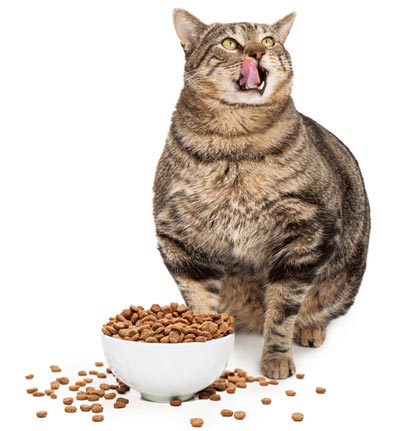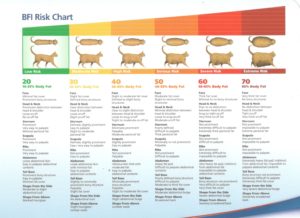
Pet obesity is on the rise, and it is time to talk about what that means for you and your pet. In 2018, nearly 60% of cats and 56% of dogs in the United States were considered obese. We see more and more pets becoming overweight and owners struggling to control it.
A healthy weight is one of the most important things that you can work to control for your pet’s well being. The charts below help define a healthy BFI for both cats and dogs and their risk level based on weight. Being overweight can cause serious health risks for your pet.
Feline health risks associated with obesity include a shortened life expectancy, diabetes, reduced mobility, arthritis, potential for physical injury, respiratory disease, hepatic lipidosis, kidney disease, cancer, and bladder stones.
Canine health risks associated with obesity include a shortened life expectancy, diabetes, reduced mobility, arthritis, potential for physical injury, respiratory disease, kidney disease, and cancer.
There are simple things that you can do to help prevent your pet from gaining weight, or help them lose the extra weight they have.
- First, cut down the treats. Giving pets a special snack is always fun, and sometimes can be helpful for training. But instead of giving your pet a high calorie treat, switch to giving them a piece of their own food instead. It will still be a special something since it is apart from meal time, but this helps keep their calories under control.
- Second, exercise. For canines, a great way to help them be active is to take them on a walk or throw the ball for them to chase in the yard or at the park. Even playing with toys inside is a great way for them to start moving. Toys are also a great way to help felines be more active, even if they are indoor cats. This ranges anywhere from feather wands to laser pointers. Giving your cat bursts of playtime throughout the day will make a difference. A feeding ball is a good choice for either pet. It helps the pet to eat slower and become more active in the process.
- Third, measure the food. The first step would be to check with Dr. Alexander or Dr. Webber to see specifically what volume you should be feeding your pet. Then it is important to use an accurately measured feeding cup to control the exact amount of food your pet is eating. By switching to this method many pet owners realize they have been over feeding their pets by eyeballing their daily intake.
If you have concerns about your pet’s weight or are struggling to control it with these methods, come by the clinic and talk to Dr. Alexander or Dr. Webber. They will be able to look into your pet’s specific needs and see if there is another route to take.



